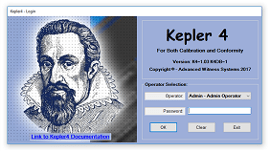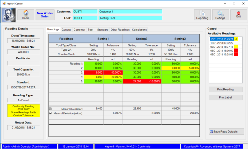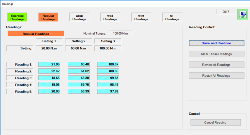Kepler 4 Software Program Suite for Torque Tool Calibration and Management
Kepler 4 software is a combined software program for the calibration and conformity of torque wrenches to BS EN ISO 6789:2017, BS EN ISO 6789:2003 or your own in house standards. It can be used for tracking torque tool calibrations, using a system of databases to keep track of each individual torque wrench and all associated information.
NEW! K factor verification to UKAS M3003 Appendices B and C using external spreadsheet module.
Try it out for yourself with a free trial.

ADMS Kepler 4 Series of software programs are designed to meet the new BS EN ISO 6789:2017 standard for conformity and calibration of Torque Tools.
ISO 6789 is the internationally recognised standard to which torque
wrenches must be calibrated. A calibration certificate to ISO 6789 states that
a tool meets quality control regulations and accurately applies the correct
torque.
Kepler 4 software is built around a new works orders database, which ties together the customer, tool,
reading & certificate.
Historic calibration and conformity certificates can be found from searching by
customer and tool, by works order number, or by certificate number.
The software program suite consists of three different versions:
- Kepler 4 Conformity
- Kepler 4 Calibration
- Kepler 4 Combined
Kepler 4 Conformity software is written to meet BS EN ISO 6789:2017 Part 1, and Kepler 4 Calibration software is written to meet Part 2. The Kepler 4 Combined software version meets both parts 1 and 2, and unlocks the use of both parts of the other two versions.
Kepler 4 can be used with ISO 6789:2003, to allow phased migration to the new standard. In-house standards can also be set up to meet specific requirements.
A full comparison between the software versions can be found on the specification page, as well as a comparison to Kepler 3. All versions allow for quick, accurate and reliable calibration of torque tools to international recognised standards, and to in-house standards.
Latest Update
We have released a major update to Kepler 4. This update brings several major benefits over the previous version, producing a more seamless operation and improving efficiency.
New K Factor Verification Module
The newly released K Factor Verification Module allows you to calculate the K Factor to UKAS M3003 Appendices B and C using an external spreadsheet.
The ability to store databases on a server rather than individual machines.
This allows multiple databases from multiple copies of Kepler 4 to be stored in one location for more efficient backup and access to results.
The ability to calibrate tools with a drive that has equal positions divisible by 6 (hexagonal drive) to ISO 6789:2017 Part 2.
Taking customer feedback into account we have implemented the calibration of hexagonal drive wrenches to ISO 6789:2017 Part 2 and this is now an option in the "Select Reading Details" screen.
The ability to search for tools by models using the models database.
This powerful new search feature has been implemented to make it much easier to add new tool data to the database and allow calculated uncertainties attached to the model. These can be imported directly into the new tool removing the need for external calculations.
The ability to calculate average values of uncertainties Bod, Bint and Bl over the last 10 calibrated tools of the same model.
Following customer feedback we have implemented this change to assist customers during calibration. Additionally customers can now print out a report of these uncertainties and use averages for bod, bint and bl. It allows the customer to use the uncertainties from 10 calibrations of the same model which will significantly decrease subsequent calibration times.
The ability to import databases from previous versions of Kepler software.
This feature allows customers with Kepler 3, Kepler 2002 and Kepler 2000 to import their existing databases into Kepler 4.
The ability to export reports into text or spreadsheet.csv formats and reimport them back into Kepler 4.
Following Customer feedback we have implemented the ability to export reports and certificate templates into text and spreadsheet formats for easier modification and back up. These can be imported back into Kepler 4 when required.
Kepler 4 Conformity
Kepler 4 Calibration
Kepler 4 Combined
Kepler 4 Conformity complies with BS EN ISO 6789:2017 Part 1, allowing the automatic calculation of the mean deviation and mean value for each setting.
The software also calculates the deviation for each reading, and indicates by colour whether the reading is within tolerance to the selected standard.


Kepler 4 Calibration complies with BS EN ISO 6789:2017 Part 2, allowing the automatic calculation using new formulae of the mean, deviation and combined uncertainty of each set of readings, for each torque tool.
The software allows full tracking of tools calibration performance and history, and the production of a report listing tools that require calibrating.
It also features Production Line capabilities, for hourly or daily tool reliance performance.

Kepler 4 Combined is a combination of the other two versions.
The software complies with BS EN ISO 6789:2017 Part 1, allowing the automatic calculation of the mean deviation and mean value for each setting. It also calculates the deviation for each reading, and indicates by colour whether the reading is within tolerance to the selected standard.
It also complies with BS EN ISO 6789:2017 Part 2, allowing the automatic calculation using new formulae of the mean, deviation and combined uncertainty of each set of readings, for each torque tool.
It allows full tracking of tools calibration performance and history, and the production of a report listing tools that require calibrating.
It also features Production Line capabilities, for hourly or daily tool reliance performance.
Shared Features
- Option to operate in 6789:2003 to allow phased migration to 6789:2017.
- Built around a new works orders database, which ties together the customer, tool, reading & certificate.
- Historic calibration and conformity certificates can be found from searching by customer and tool, by works order number, or by certificate number within the Kepler 4 Software.
- User generated databases for customers, instruments, tools, model types, & standards.
- Multiple operator accounts for users, maintainers & administrators (with passwords).
- Data output and report generation collated and filtered from any combination of good and out of tolerance tools.
- Auto or manual certificate numbering.
- Select different printers for readings, labels, and reports/certificates.
- Fast tool entry from model database.
- Multiple translations available, including the facility to create your own translations for the software.
- Tool performance & data input via COM port and keyboard.
- Option for bar code direct entry into the software.
- Bespoke templates easily created for certificates, reports and labels within the software.
- Import and Export readings for efficient database usage.
- Cloning facility speeds multiple tool data entry.
- Archive all readings within a selected period.
- Tool area and station location.
- All certificate print details recorded. Enables exact facsimile reproduction.
- Auto print option to print reports of readings as soon as they are completed.
- New operating & improved screens.
- Colour configuration.
System Requirements:
Minimum Screen Resolution: 1280x768.
Software is a .NET application using an SQL Database.
Minimum System: i5 Processor or equivalent, 4GB RAM, on board graphics, 500GB HDD.
Keyboard & Mouse Interface.
Software Comparison
|
Feature |
Kepler Lite 3 |
Kepler 3 |
Kepler 4 |
||
|
Conformity |
Calibration |
Combined |
|||
|
Complies with ISO 6789:2003 and BS EN 26789:2003 torque standards. |
ü |
ü |
ü |
ü |
ü |
|
Full tracking of tool tightening performance. |
ü |
ü |
ü |
ü |
ü |
|
Full tracking of tools calibration performance and history. |
ü |
ü |
ü |
ü |
ü |
|
Tool performance & data input via COM port and keyboard. Option for bar code direct entry. |
ü |
ü |
ü |
ü |
ü |
|
Shows torque out of limits for selected tool. |
ü |
ü |
ü |
ü |
ü |
|
Automatically calculates average and deviation of each set of readings. |
ü |
ü |
ü |
ü |
ü |
|
User generated database for tool types and torque parameters required. |
ü |
ü |
ü |
ü |
ü |
|
Data output and report generation collated and filtered from any combination of good and out of tolerance tools. Uses include monthly reports, etc. |
ü |
ü |
ü |
ü |
ü |
|
Calibration Instrument/Machine/Inspection details. |
ü |
ü |
ü |
ü |
ü |
|
Bespoke templates easily created for your certificates, reports and labels within the software. |
ü |
ü |
ü |
ü |
ü |
|
Auto or manual certificate numbering. |
ü |
ü |
ü |
ü |
ü |
|
All certificate print details recorded. Enables exact facsimile reproduction. |
ü |
ü |
ü |
ü |
ü |
|
Select different printers for readings, labels, and reports/certificates. |
ü |
ü |
ü |
ü |
ü |
|
Translation screens and print out can be converted to the language of your choice. |
ü |
ü |
ü |
ü |
ü |
|
Multiple operator accounts (With password protection). |
ü |
ü |
ü |
ü |
ü |
|
Produce a report listing tools that require calibrating. |
|
ü |
ü |
ü |
ü |
|
Tool identification and serial number identification. |
|
ü |
ü |
ü |
ü |
|
Fast tool search by user set criteria. |
|
ü |
ü |
ü |
ü |
|
Tool area and station location. |
|
ü |
ü |
ü |
ü |
|
Cloning facility speeds multiple tool data entry. |
|
ü |
ü |
ü |
ü |
|
Colour configuration. |
|
ü |
ü |
ü |
ü |
|
Complies with BS EN ISO 6789:2017 Part 1, allowing the automatic calculation of the mean deviation and mean value for each setting. |
|
|
ü |
|
ü |
|
Calculates the deviation for each reading, and indicates by colour whether the reading is within tolerance to the selected standard. |
|
|
ü |
|
ü |
|
Complies with BS EN ISO 6789:2017 Part 2, allowing the automatic calculation using new formulae of the mean, deviation and combined uncertainty of each set of readings, for each torque tool. |
|
|
|
ü |
ü |
|
Full tracking of tools calibration performance and history. Produce a report listing tools that require calibrating. |
|
|
|
ü |
ü |
| Calculate K Factor to meet UKAS M3003 Appendices B and C. | ü | ü | |||
|
Production Line capabilities, for hourly or daily tool reliance performance. |
|
|
|
ü |
ü |
|
Model readings can be analysed to generate average bod, bint and bl values from 10 or more tools, to be used for future tools. |
|
|
ü |
ü |
ü |
|
Instrument database which allows combination of 5 instrument items, such as TD/Lead/Display. |
|
|
ü |
ü |
ü |
|
Standards database, including ISO 6789:2017 & 2003 pre-entered. |
|
|
ü |
ü |
ü |
|
Historic calibration and conformity certificates can be found from searching by customer and tool, by works order number, or by certificate number. |
|
|
ü |
ü |
ü |
|
User generated databases for customers, instruments, tools, models, & standards. |
|
|
ü |
ü |
ü |
|
Fast tool entry from model database. |
|
|
ü |
ü |
ü |
|
Import signatures as pictures. |
|
|
ü |
ü |
ü |
|
Implementation of works order tracking system. |
|
|
ü |
ü |
ü |
|
New simplified and improved screen layouts. |
|
|
ü |
ü |
ü |
|
New system using .NET framework and sequel databases. |
|
|
ü |
ü |
ü |
Find Out More